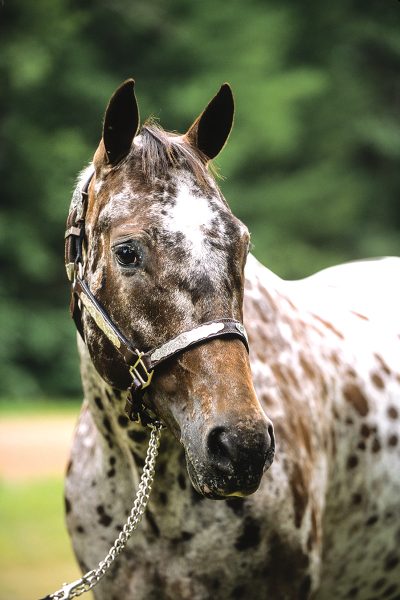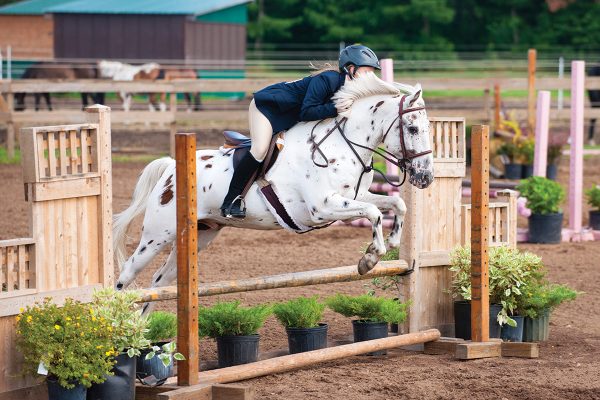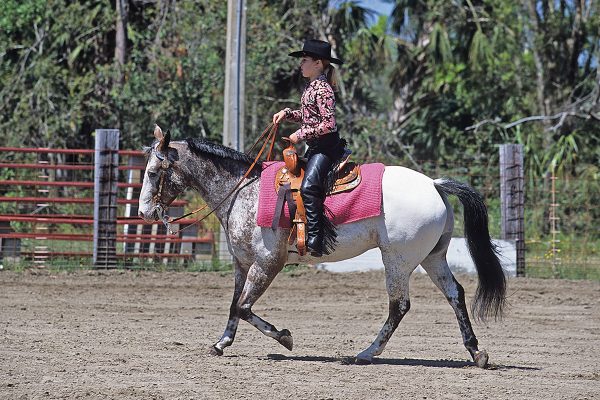Mason City, Iowa, is situated in the heart of Iowa, and it’s probably best known as the birthplace of composer Meredith Willson of The Music Man fame. But the city is also famous for another reason: it’s the birthplace of a beloved American pony breed, the Pony of the Americas.

In the mid-1950s, at about the time Meredith Willson was busily composing the songs for The Music Man, another Mason City man—a lawyer named Les Boomhower—was raising Shetland Ponies. In 1954, Boomhower purchased a uniquely marked Arabian/Appaloosa/Shetland colt.
Boomhower could see the potential in the colt, and he could also envision a new pony breed, one that had or stock-type (western) characteristics and a gentle disposition with Appaloosa markings.
Boomhower’s colt, later named Black Hand, went on to become the foundation stallion for the Pony of the Americas (POA) breed. Over time, other breeds contributed to the development of the POA, including Thoroughbreds, Welsh Ponies, and American Quarter Horses.
Today, certain approved breeds can still be crossed with POAs to produce registered offspring, including Connemara Ponies, Appaloosas, Thoroughbreds, Arabians, and American Quarter Horses. Other breeds, like Welsh Ponies, are approved on an individual, case-by-case basis.
Why the Pony of the Americas is the Total Package
Today’s POAs are known for their kind and trainable natures and their suitability for young riders. Their ideal size (11.2 to 14 hands) makes them a go-to choice for anyone interested in a pony that can excel in western disciplines. But don’t overlook the POA’s versatility—they also compete in English classes, hunters, driving and dressage.
Versatile, intelligent, and gentle: sounds like a perfect pony, right? But the POA makes the best even better by adding in the icing on the cake with their eye-catching coat patterns.

The Appaloosa-like coat patterns are a very important part of the POA breed. To be fully registered, POAs must exhibit “recognizable color and characteristics at 40 feet,” which means that the pattern must be visible from a distance. (Paint or pinto patterns are not allowed, however.)
Spotlight on Youth
If you’d like to get involved with a breed that has plenty of opportunities for youth exhibitors, you’ll find lots of fun in the POA world. Unlike some breed registries that focus on adult exhibitors and offer limited youth programs, the Pony of the Americas Club, Inc. (POAC) focuses heavily on youth exhibitors.
There are more than 40 state clubs affiliated with the POAC. Breed shows filled with youth classes are held throughout the United States all throughout the show season.
Of particular note is the week-long POAC National Congress show held every July with over 200 classes, ranging from western pleasure and trail to reining and hunter hack. The Congress also has games, speed events and more—they even offer a graduation ceremony to celebrate and recognize graduating high school seniors who have been involved with POAs.

In addition to showing opportunities, the POAC offers scholarship awards for youth members. They also offer a Hall of Fame for people and ponies who have made a lasting impact on the breed in their lifetime.
And if endurance riding or trail riding is your thing, be sure to check out the POAC’s Endurance and Competitive Trail Riding Medallion award. Participants log miles ridden in sanctioned events and must ride 50 miles within a calendar year.
If equitation is more your style, the POAC awards an Equitation Traveling Trophy in three age brackets (9 and under, 10-13, and 14-18) for exhibitors who achieve the most points in equitation and horsemanship events.
For more information on the Pony of the Americas Club, Inc., including information on their programs for youth, visit www.poac.org.
Fast Facts about the POA
◆ POAs range in size from 11.2 to 14 hands.
◆ POA base colors can be bay, black, red, dun, grulla, red dun buckskin, smoky black, smoky cream, cremello, perlino, palomino, bay roan, blue roan, or red roan. In addition to the base color, POAs exhibit many color patterns, including snowflake, frost, leopard, roan, marbleized roan, blanket, et cetera.
◆ Additional characteristics are common with POAs: striped hooves, white sclera (around the edge of the eye), varnish marks, and parti-colored (mottled) skin on the muzzle and other areas.
This article about the Pony of the Americas (POAs) appeared in the July/August 2023 issue of Young Rider magazine. Click here to subscribe!


